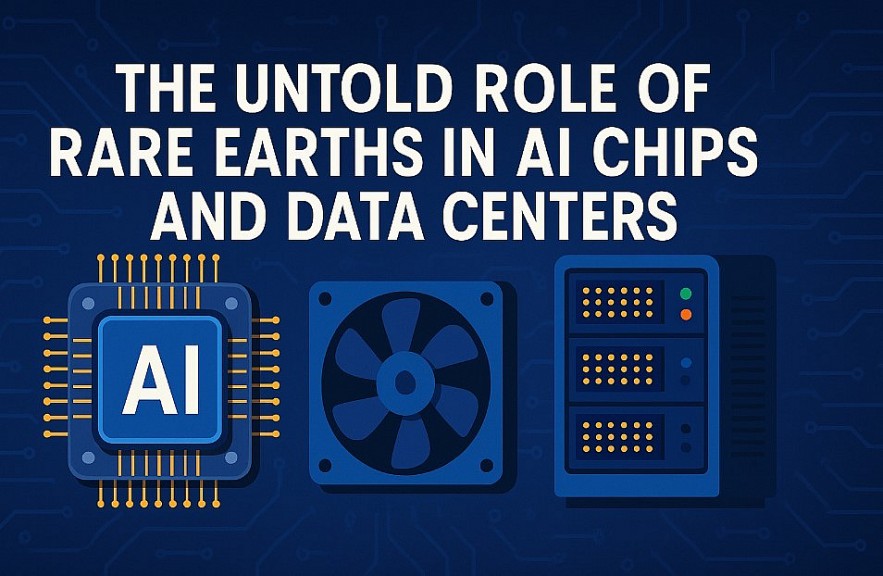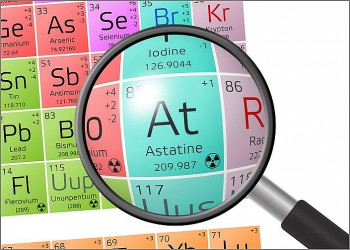The Untold Role of Rare Earths in AI Chips and Data Centers
 Rare Earthquake Hits Magee, Mississippi, as Tornadoes Devastate the Region Rare Earthquake Hits Magee, Mississippi, as Tornadoes Devastate the Region |
 Why Rare Earth Recycling Will Be the Next Big Green Investment (2025–2030 Outlook) Why Rare Earth Recycling Will Be the Next Big Green Investment (2025–2030 Outlook) |
 |
| Minerals Behind AI’s Big Boom |
The Hidden Minerals Behind AI’s Big Boom
Artificial intelligence isn’t just software—it’s infrastructure. Behind every chatbot response, image generator, or algorithmically optimized feed lies a massive web of AI chips, server racks, cooling systems, and data transmission hardware.
But few realize that this web runs on more than just silicon and electricity. It depends on a small but crucial group of materials: rare earth elements (REEs).
As the world builds toward an AI-powered future, the demand for rare earths in AI chips and data centers is quietly exploding—and the global supply chain may not be ready.
What Are Rare Earths—and Why Are They Critical for AI?
Rare earth elements are a group of 17 chemically similar metals used in high-performance electronics and magnets. Despite the name, they’re not rare in Earth's crust—but economical extraction and refinement are highly concentrated and geopolitically sensitive.
The AI industry relies heavily on REEs for several functions:
1. Permanent Magnets (Neodymium, Dysprosium, Terbium)
Used in:
-
Cooling fans in GPUs and CPUs
-
Motors in high-efficiency server cooling systems
-
Power-dense components in robotics and AI-driven automation
2. Phosphors and Lasers (Yttrium, Europium, Cerium)
Used in:
-
Optical components in high-speed data transfer
-
Quantum computing and laser-based AI research equipment
3. High-k Dielectrics and Additives (Lanthanum, Cerium)
Used in:
-
Advanced semiconductor processing
-
Chip packaging and reliability layers
These elements are essential for performance, heat resistance, miniaturization, and energy efficiency—everything that hyperscale AI infrastructure demands.
Why AI Is Fueling a Rare Earth Demand Spike
The rise of AI—particularly large language models (LLMs) like ChatGPT, Gemini, Claude, and open-source rivals—has triggered unprecedented hardware demand:
• AI Chips Are Scaling Fast
-
NVIDIA’s H100 and B100 chips are selling in the millions annually
-
AMD, Intel, and Google TPU production ramping up
-
Each AI chip node integrates rare earths in fans, connectors, and packaging materials
• Data Centers Are Exploding in Size and Number
-
Over 10,000 data centers globally, with hyperscale centers expected to double by 2030
-
Each data center requires thousands of server fans and power-efficient motors
-
AI workloads increase thermal demands, pushing magnet-based cooling to its limits
• Energy Efficiency and Heat Management Are Non-Negotiable
-
Neodymium-based magnets are used in liquid cooling pumps and active cooling units
-
Rare earths enable precision miniaturization, essential in high-density AI chips
In short: No REEs, no scalable AI.
Neodymium: The Unsung Hero of AI Infrastructure
Among all rare earths, neodymium plays the most outsized role in AI infrastructure.
Why Neodymium Matters:
-
Found in NdFeB (neodymium-iron-boron) magnets
-
Delivers high magnetic strength in compact form
-
Operates efficiently at high temperatures (essential for dense GPU arrays)
Where It’s Used:
-
Cooling fans in AI servers and GPUs
-
Precision motors in robotic arms used for server maintenance
-
Wind turbines and power generation systems powering green data centers
In fact, a single hyperscale data center may use over 600 kg of neodymium-based magnets—and demand is rising fast.
Rare Earths in AI Chip Manufacturing
Though silicon remains the heart of semiconductors, REEs are indispensable in:
• Semiconductor Doping & Processing
-
Lanthanum improves dielectric properties in microchips
-
Cerium used in polishing wafers and chip substrates
• Packaging Materials
-
Yttrium and cerium oxides improve thermal stability of packages
-
Enhanced performance for AI chips running 24/7 at extreme speeds
• Quantum AI and Edge Computing
-
Lasers and photonics rely on erbium, terbium, and yttrium
As AI hardware moves toward edge processing and quantum acceleration, these lesser-known REEs will become even more critical.
Geopolitical Risks and the AI Supply Chain
Over 80% of the world’s refined rare earth supply comes from China, which has repeatedly used REE exports as a strategic lever. In 2023, China imposed new restrictions on gallium and germanium, prompting fears of rare earth embargoes next.
The AI race has added urgency:
-
The U.S. has labeled REEs as “critical to national security”
-
The EU is developing a Critical Raw Materials Act targeting rare earth independence
-
Tech giants like NVIDIA, Microsoft, and Amazon are quietly hedging against REE risk
A shortage of neodymium or dysprosium could cripple chip cooling systems, reduce energy efficiency, or delay AI server deployment—all at massive economic cost.
REE Recycling: A Future-Proof Strategy for AI Companies
To hedge against geopolitical shocks and environmental concerns, rare earth recycling is gaining momentum in AI and cloud sectors.
Key benefits:
-
Reduced dependence on mining and Chinese refining
-
Lower carbon footprint compared to virgin extraction
-
Enables a circular economy for servers, fans, and AI hardware
Companies leading the charge:
-
Urban Mining Co. (USA) – magnet-to-magnet REE recycling
-
HyProMag (UK) – rare earth recovery from e-waste
-
Apple – built custom robots to recover REEs from iPhones (now exploring server-grade components)
Expect hyperscalers to begin demanding recyclable-by-design server components over the next 5 years.
What’s Next: Forecasting the Rare Earth-AI Connection (2025–2030)
| Year | Trend | Impact |
|---|---|---|
| 2025 | AI chips surpass 200 million units/year | Exponential demand for REE-based cooling |
| 2026 | First “REE-free” AI cooling prototype released | Possible disruption—but limited impact |
| 2027 | REE recycling adoption in hyperscale data centers | Circular AI infrastructure begins |
| 2028 | AI edge devices use custom REE alloys | Increase in terbium, yttrium demand |
| 2030 | 30% of REEs in AI hardware from recycled sources | Supply chain stabilization |
Conclusion: Rare Earths Are the Silent Force Behind AI’s Rise
AI is often framed as a battle of algorithms, compute power, or data—but the real bottleneck might be materials. Without a stable, sustainable supply of rare earths like neodymium, dysprosium, and yttrium, AI chips can’t run cool, servers can’t scale, and data centers can’t expand fast enough.
For investors, engineers, and policymakers, understanding the critical role of REEs in AI infrastructure is no longer optional—it’s urgent.
The smarter AI gets, the more it depends on the ground beneath our feet.
Frequently Asked Questions (FAQs)
What rare earth elements are used in AI chips and servers?
Primarily neodymium (for magnets in fans and motors), lanthanum and cerium (for chip packaging and polishing), and yttrium, terbium, and europium (for optics and lasers).
Why are rare earths important for data centers?
They enable high-efficiency cooling, miniaturized motors, and stable high-performance environments—all crucial for AI workloads.
Can rare earths be recycled from AI hardware?
Yes. Fans, server motors, and old chips contain REEs that can be recovered and reused. Rare earth recycling is gaining adoption among tech giants.
Is the AI industry at risk from rare earth shortages?
Yes. Over-reliance on Chinese REE supply creates geopolitical risks. A disruption could slow AI chip production and server deployment.
Are there REE-free alternatives for AI cooling?
Research is ongoing, but no material currently matches the efficiency and size of REE-based permanent magnets at scale.
 What are the Rarest Elements On Earth - Top 11 What are the Rarest Elements On Earth - Top 11 Can you name all the earth's rare elements? Is there a rarest variety? Keep reading to learn some fascinating information about some of the earth's ... |
 What are Rare Earth Elements: The Top 10 Countries with the Largest Reserves What are Rare Earth Elements: The Top 10 Countries with the Largest Reserves KnowInsiders delves into the significance of rare earth elements (REEs) and highlights the top 10 countries boasting the largest reserves, based on the latest data ... |
 What Are Rare Earth Elements and Why Are They So Important? What Are Rare Earth Elements and Why Are They So Important? KnownInsiders explore what Rare earth elements (REEs) are, why they are indispensable, and how their demand is shaping global geopolitics. |























